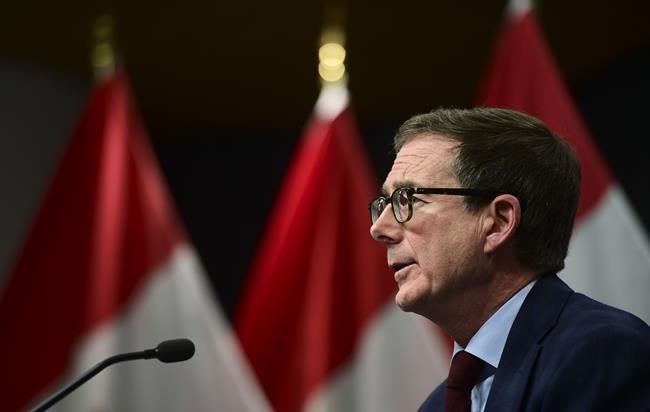OTTAWA — The governor of the Bank of Canada pressed the case for COVID-19 vaccines to be sent to developing nations as part of a broader push to not only end the pandemic, but aid Canada's economic recovery and ease price pressures on consumer goods.
In a speech Thursday, Tiff Macklem said the shots are saving lives and livelihoods, and underpinning the global economic recovery.
While vaccine development highlighted international co-operation at its finest, Macklem suggested the same can't said of ensuring equitable access of vaccines to countries, especially in developing nations.
COVID-19 is the biggest health and economic risk facing the world, and governments and the private sector must work together to make vaccines available to all, Macklem said in a speech to the American-based Council on Foreign Relations.
Domestically, tens of millions of doses have been delivered and shots provided over the last year to the point where over 82 per cent of eligible Canadians over age 12 are now fully vaccinated.
But the same can't be said of other parts of the world, particularly in emerging economies, and regions of the world Canada relies on for goods.
Ongoing outbreaks in other parts of the globe affect supply chains that in turn impacts inventories of in-demand consumer goods, the delivery of parts needed to build things here like cars, and pushes up transportation costs.
All that drives up overall consumer prices.
"It feels like we're we're getting out of the pandemic, but it's important to remember that large parts of the rest of the world are still struggling greatly with the pandemic," said Deloitte Canada chief economist Craig Alexander.
"Part of the inflation story that is playing out right now where inflation has picked up, part of that is actually a reflection of the the ongoing pandemic outside of Canada."
Annual inflation rates have run above the Bank of Canada's comfort zone since April, reaching 4.1 per cent in August. The central bank expects elevated readings above its target zone of roughly two per cent though the rest of the year.
Macklem said inflationary pressures should ease as prices are no longer compared to lows early on in the pandemic, and as trade bottlenecks work themselves out. The bottlenecks are proving more persistent than previously thought, and similarly could lead to higher inflation readings, he said.
"This pandemic keeps throwing new curveballs," he told reporters after the event.
"It might take a little bit longer, but we do continue to believe there are good reasons why the impact of these supply disruptions on inflation should be temporary, and there are good reasons to believe that economy, the recovery, will pick up and continue."
Still, he said the central bank is closely watching for signs that temporary factors are becoming more permanent, noting that "our margin of error on inflation is diminished."
Macklem also said discussions about working through these global issues should come up when he travels next week to Washington, D.C. as part of his first international trip since taking the helm of the Bank of Canada early in the pandemic.
He is scheduled to attend the annual meetings of the International Monetary Fund and World Bank, as well as meetings with his G7 and G20 counterparts.
In his speech, Macklem spoke about the need for countries to chart a path out of the pandemic that balances short-term needs with long-term goals, such as the transition to net-zero economies.
Finding that balance is even more crucial as central banks prepare to wind down stimulus programs and likely put the global financial system under more pressure, he said.
The Bank of Canada has already started to unwind one of its key stimulus programs launched at the start of the pandemic by rolling back its weekly purchases of federal bonds.
The program, known as quantitative easing, is designed to encourage low interest rates on things like mortgages and business loans, but could soon move to a phase where it no longer adds stimulus, but only maintains what is there.
Similarly, the central bank's key policy rate has stayed at 0.25 per cent since the start of the pandemic, which is as low as the bank says it will go, and where it should stay until the second half of next year when the Bank of Canada expects the economy to have healed enough to handle higher interest rates.
This report by The Canadian Press was first published Oct. 7, 2021.
Jordan Press, The Canadian Press




